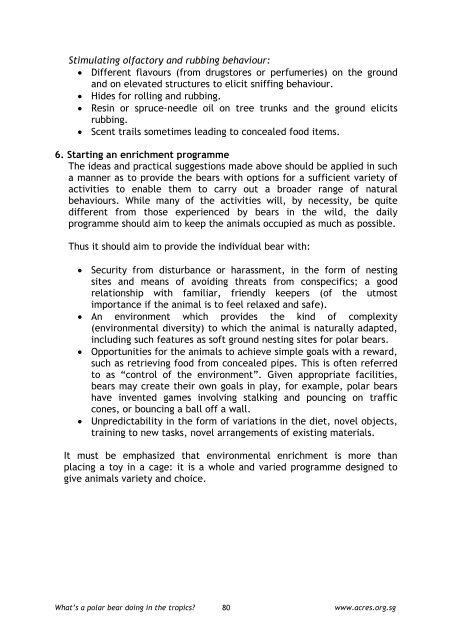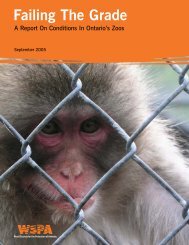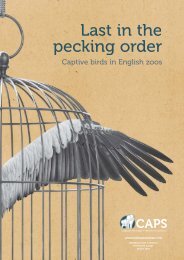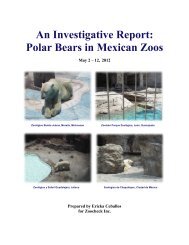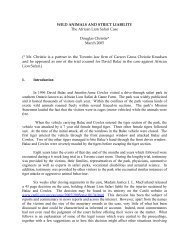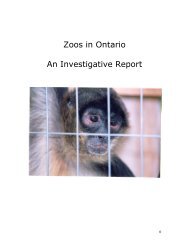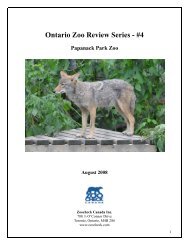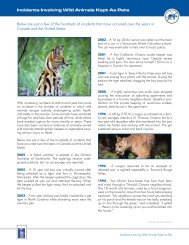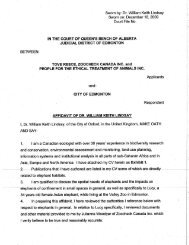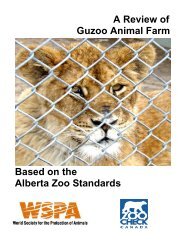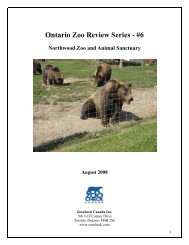What's a Polar Bear Doing in the Tropics? - Animal Concerns ...
What's a Polar Bear Doing in the Tropics? - Animal Concerns ...
What's a Polar Bear Doing in the Tropics? - Animal Concerns ...
You also want an ePaper? Increase the reach of your titles
YUMPU automatically turns print PDFs into web optimized ePapers that Google loves.
Stimulat<strong>in</strong>g olfactory and rubb<strong>in</strong>g behaviour:• Different flavours (from drugstores or perfumeries) on <strong>the</strong> groundand on elevated structures to elicit sniff<strong>in</strong>g behaviour.• Hides for roll<strong>in</strong>g and rubb<strong>in</strong>g.• Res<strong>in</strong> or spruce-needle oil on tree trunks and <strong>the</strong> ground elicitsrubb<strong>in</strong>g.• Scent trails sometimes lead<strong>in</strong>g to concealed food items.6. Start<strong>in</strong>g an enrichment programmeThe ideas and practical suggestions made above should be applied <strong>in</strong> sucha manner as to provide <strong>the</strong> bears with options for a sufficient variety ofactivities to enable <strong>the</strong>m to carry out a broader range of naturalbehaviours. While many of <strong>the</strong> activities will, by necessity, be quitedifferent from those experienced by bears <strong>in</strong> <strong>the</strong> wild, <strong>the</strong> dailyprogramme should aim to keep <strong>the</strong> animals occupied as much as possible.Thus it should aim to provide <strong>the</strong> <strong>in</strong>dividual bear with:• Security from disturbance or harassment, <strong>in</strong> <strong>the</strong> form of nest<strong>in</strong>gsites and means of avoid<strong>in</strong>g threats from conspecifics; a goodrelationship with familiar, friendly keepers (of <strong>the</strong> utmostimportance if <strong>the</strong> animal is to feel relaxed and safe).• An environment which provides <strong>the</strong> k<strong>in</strong>d of complexity(environmental diversity) to which <strong>the</strong> animal is naturally adapted,<strong>in</strong>clud<strong>in</strong>g such features as soft ground nest<strong>in</strong>g sites for polar bears.• Opportunities for <strong>the</strong> animals to achieve simple goals with a reward,such as retriev<strong>in</strong>g food from concealed pipes. This is often referredto as “control of <strong>the</strong> environment”. Given appropriate facilities,bears may create <strong>the</strong>ir own goals <strong>in</strong> play, for example, polar bearshave <strong>in</strong>vented games <strong>in</strong>volv<strong>in</strong>g stalk<strong>in</strong>g and pounc<strong>in</strong>g on trafficcones, or bounc<strong>in</strong>g a ball off a wall.• Unpredictability <strong>in</strong> <strong>the</strong> form of variations <strong>in</strong> <strong>the</strong> diet, novel objects,tra<strong>in</strong><strong>in</strong>g to new tasks, novel arrangements of exist<strong>in</strong>g materials.It must be emphasized that environmental enrichment is more thanplac<strong>in</strong>g a toy <strong>in</strong> a cage: it is a whole and varied programme designed togive animals variety and choice.What’s a polar bear do<strong>in</strong>g <strong>in</strong> <strong>the</strong> tropics?80www.acres.org.sg


